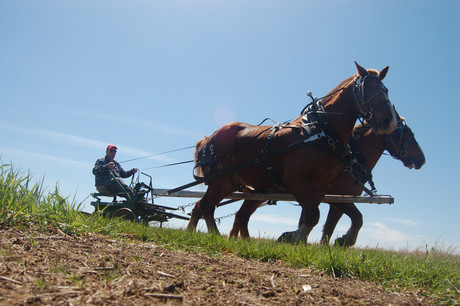The Wrack
The Wrack is the Wells Reserve blog, our collective logbook on the web.
The Wrack is the Wells Reserve blog, our collective logbook on the web.

The following was published in the Biddeford-Saco Journal Tribune Sunday edition, 8/9/2015.
My car, a Volkswagen Jetta with a diesel engine, generates 140 horsepower. I sometimes imagine what it would be like to ride in a horse-drawn carriage down I-95 to my office at the Wells Reserve at Laudholm, towed by 140 horses. Using eight feet as the average length of a horse, and pairing the horses together, my anachronistic folk’s wagon would rumble along behind an equine train more than 560 feet long.
I wonder what our top speed would be.
Probably not the 75 miles per hour I’m used to. Negotiating the Turnpike’s off-ramps, not to mention the Casco Bay Bridge, would certainly be challenging with my 140 horses, though not as challenging as feeding them. Even worse: what goes in must come out.
Back in the days of literal horsepower, the byproducts of that energy were the major source of urban pollution. In New York City circa 1880, roughly 175,000 horses plied the streets, pulling buses and wagons and using their horsepower to move a city around. According to estimates, those horses produced 40,000 gallons of urine and 3 million pounds of manure every day. City planners predicted with dread that piles of dung would eventually reach the third story.
I think I’ll stick with my sedan.
Nowadays, this seems like a no-brainer trade. But the horse breeders, the wagon makers, and the farriers (those who shoe horses) fiercely opposed the transition to electric streetcars and ultimately Henry Ford’s “horseless carriage.” A writer in Lippincott’s Magazine at the time insisted that since “Americans are a horse-loving nation… the widespread adoption of the motor-driven vehicle in this country is open to serious doubt.”
But despite the neigh-sayers, by 1920 the internal combustion engine was quickly seen as not only a time- and labor-saving device but also the only solution to the “unsolvable problem” of urban horse pollution. The energy transition from literal horse power to other forms of horsepower eventually made the entire draft horse industry obsolete, though it took 50 years to make the switch.
Funnily enough, it was James Watt, the inventor of the coal-powered steam engine, who invented the term “horsepower.” Today, one turbine in a coal-fired power plant can generate 1.5 million horsepower. Nothing is free, though: the “manure” from all those “horses” has been steadily piling up, invisibly and irrevocably, in our atmosphere. I’ll admit that, in one way, I agree with today’s climate change deniers: the carbon dioxide emitted by the burning of coal is our generation’s horsesh**. It’s been deemed, by the power producers and other business interests, a nonexistent or, at least, unsolvable problem.
But then last Monday President Obama, in the boldest conservation move of his presidency, directed the Environmental Protection Agency to institute new rules to regulate the amount of carbon dioxide power companies can emit. The goal of the new rules is to, by 2030, reduce emissions by 32 percent from their 2005 levels. Coal-fired power plants are the largest sources of carbon dioxide pollution in the country; the President’s Clean Power Plan is a major step towards cleaning up our atmosphere.
Predictably, the power companies and the coal mining industry have cried foul. Electricity rates will skyrocket, they warn. Businesses will fold, the economy will collapse.
Except that it hasn’t. In the nine states, including Maine, that formed the cap-and-trade Regional Greenhouse Gas Initiative in 2005, none of the industry’s dire warnings have played out. Quite the opposite, in fact: RGGI has created 14,000 jobs and saved consumers in the Northeast more than $460 million through lower electric bills, all while significantly reducing carbon emissions.
Back in the 1980s, corporate catastrophists similarly decried the EPA’s rules to combat the acid rain that was falling on Maine’s lakes and forests. But common sense and market forces prevailed: the power industry cleaned up its act and sulfur dioxide levels came down.
Climate change is a bigger, more widespread problem than acid rain, and more urgent. America’s coastal communities, according to a recent paper from University of Maine civil engineering professor Shaleen Jain, are at severe risk from global warming. If we value our Maine way of life, we must expand successful programs like the Regional Greenhouse Gas Initiative with national moves like the Clean Power Plan.
Or, we could keep using horses and watch the… waste… hit the fan.
Nik Charov is president of Laudholm Trust, the nonprofit partner of the Wells National Estuarine Research Reserve in Wells, Maine. His Sunday column, “Between Two Worlds,” ventures forth from the intersection of art and science, past and future, EPA and PPM. More at wellsreserve.org/twoworlds.